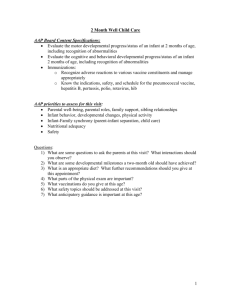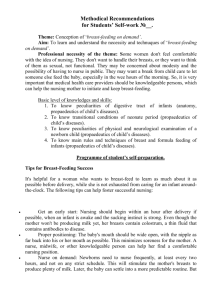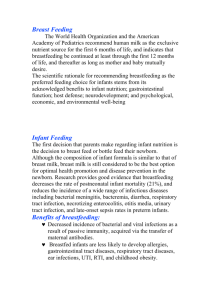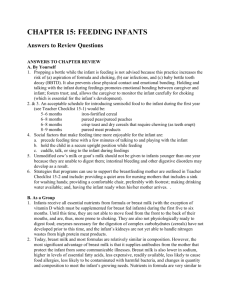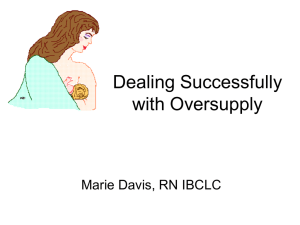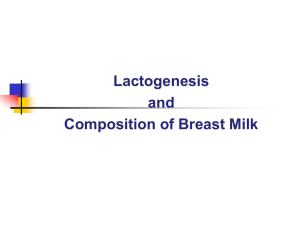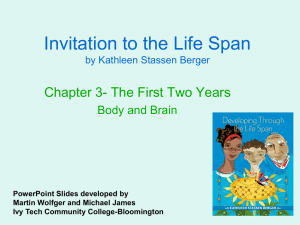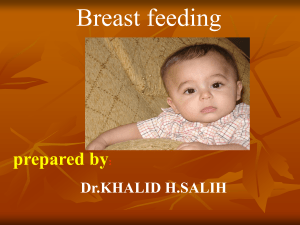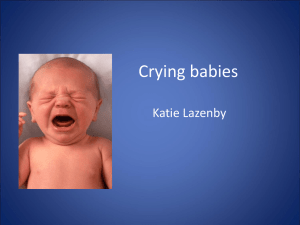Chapter_3_Student_
advertisement
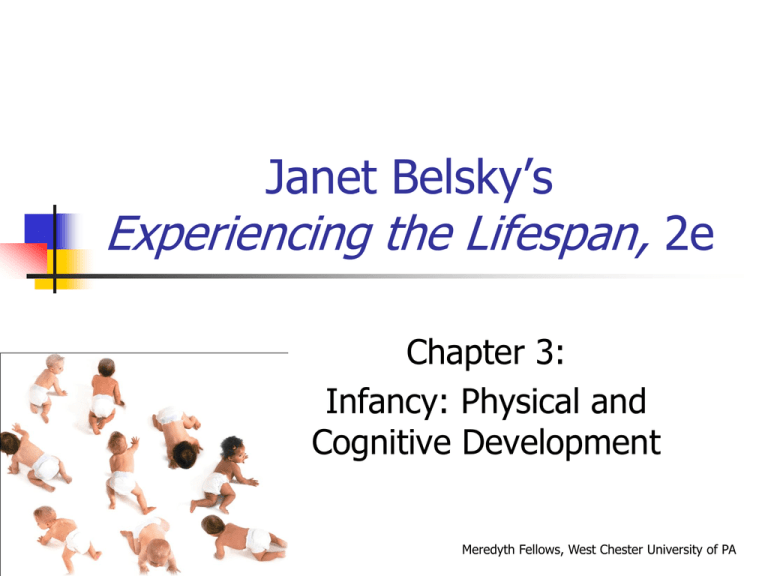
Janet Belsky’s Experiencing the Lifespan, 2e Chapter 3: Infancy: Physical and Cognitive Development Meredyth Fellows, West Chester University of PA Postpartum Depression _______________________ Data from three states indicate that nearly 12% of women reported being moderately depressed after they delivered their baby, and 6% reported being very depressed after delivery. In addition to directly influencing the emotional wellbeing of mothers, postpartum depression (PPD) has been shown to affect marital relationships, mother–infant bonding, and infant behavior The Expanding Brain: Blossoming and Sculpting Brain Growth Following Birth Experiences fastest growth during infancy Cerebral cortex comes “on-line” a few months after birth Cerebral Cortex: outer folded mantle of brain; responsible for thinking, reasoning, perceiving, and all conscious processes In 20 years brain volume quadruples and growth is complete. The Expanding Brain Recall during fetal period neurons are formed After birth, _______________ proliferation of connections at the synapses Exuberant synaptogenesis and __________ _________: formation of fatty layer encasing axons Visual cortex myelinated by 1 year Frontal lobes, age 20 or beyond Neural Pruning and Plasticity: Interaction of Nature and Nurture _________: the brain is “plastic” (malleable) during early childhood before pruning is complete Following a brain injury or insult, plasticity allows other brain regions to compensate Following childhood the brain is less plastic Rehabilitation following a brain injury will help to compensate for the injury (e.g following a stroke). Basic Newborn States: Reflexes Reflexes: Instinctive, automatic responses Present at birth; promote survival ____________________ ____________________ ____________________ Nutrition: Breast Milk Breast Milk: recommended for 1st six months Protects from diseases Correlational studies show that breast-fed babies: are more alert during first two weeks experience fewer gastrointestinal problems and ear infections are more resistant to day care diseases, colds and flu are advanced in developmental tasks as toddlers appear to be superior in later measures of intelligence in elementary school (cautious assumption – next slide!) Nutrition: Breast Milk Breast Milk Studies: must consider 3rd variable – Social Class Mothers from higher SES may have more opportunity to breast feed (lower SES mothers may have to work). Health - premature babies may not have the opportunity Health of the mother may deter breast feeding (HIV) Social support and a culture that supports breast feeding are crucial factors in the choice to breast feed. Crying: First Communication Signal Crying: Lifetime peak at about 5 weeks Reflex dominated before the cortex is “on-line” at 4 months Vital to survival (responsive parenting is a must!) _________: frantic, continual crying during first 3 months Caused by immature digestive system Another expert’s suggestion: immature nervous system May contribute to parental stress, but is temporary! Intervention: What Quiets a Young Baby? Pacifier __________ Kangaroo Care Mirrors womb Hold close to body in baby sling Infant Massage Helps to calm infants and contributes to growth in premature babies Sleeping: Main Newborn State Newborns, 18 hrs. a day Note high % of sleep states: drowsy, quiet, and REM sleep Unlike adult sleep cycle, newborns drop immediately into REM sleep Newborns wake every 3-4 hours 6 months, may sleep 6 hrs. a night 1 year, 12 hrs. a night and naps during day Sleep Cycles Sensory and Motor Development Hearing Smell In the womb, fetuses can discriminate different tones Infants prefer smell of breast milk within the first week Taste: Infants stop sucking and wrinkle face in response to bitter, sour, salty tastes Avidly suck on sweet solutions Pain management technique - have infant suck on sweet substance Focusing on Faces Newborns prefer faces to other stimuli, especially mother’s face Prefer attractive-looking people Infants mimic facial expressions Depth Perception: the Visual Cliff Experiment When 8 month-old babies begin to crawl they perceive differences in depth and fear heights. Notice survival response! Video Joe Campos Cognitive Development: Piaget Stage Approach Studied his children Schemas Assimilation Accommodation Adaptation Cognition Sensorimotor Stage: birth to 2 Explore world through senses _______________ Repetitive action-oriented schemas (habits) Primary (body-centered), Secondary (environment), Tertiary (“little scientist”) Through circular reactions, infant explores and incorporates new information into existing schemas Sensorimotor Stage Stage 1: reflexes 0-1 month Proficiency at sucking, grasping Lack ability to deliberately grasp or suck Stage 2: primary circular reactions 1-4 months Repetition of pleasurable behavior which occurs by chance (involves own body) Stage 3: secondary circular reactions 4 – 8 months Repetition of pleasurable behavior which occurs by chance, but involves deliberate manipulation of object in environment Stage 4: purposeful coordination of secondary schemes 8-12months Combinations of actions (leaning and grasping) (looking, crawling, grasping) Stage 5: tertiary circular reactions 12 – 18 months Exploration using new or novel actions Formation of trial and error discovery Stage 6: mental solutions 18 – 24 months Thinking about problems to develop solutions Internalization of trial and error Accompanied by language formation Tracking Early Thinking: Sensorimotor Stage _____________: repeating an action observed at an early time Means-end behavior: about 1 yr., performing a different action to reach a goal Flushing something down the toilet! ____________: even though a baby sees an object hidden in a 2nd hiding place, he/she goes back to the first hiding place to find it! Classic mistake in Sensorimotor stage Baby approaches 1 year (little-scientist stage) A-not-B Error: Sensorimotor Stage-Video Object-Permanence: Sensorimotor Stage Understanding that objects exist even when we can no longer see them. In the early Sensorimotor stage, an object does not exist unless the infant can see it! Around 5-6 months, infants begin to look for hidden objects About 8 months develops object-permanence (“little-scientist stage”) Peek-a-Boo a favorite game!! Sequence of Language Development Prelinguistic Period ◦ ◦ ◦ Crying at birth _______(video) at 2 months _________(video) at 6 months Spoken Words- Video ◦ Appears at about 10 months ◦ Typically only a few words are known By 18 months between 3 to 50 words Two word utterances begin 18 to 24 months _________(Video) appear at about 2 to 4 years Language: Basic Principles _________ language abilities outpace expressive language skills Infant-directed speech Higher pitched, elongated vowels, exaggerated tones Attracts baby’s interest (heart rate deceleration evidence of baby’s interest)

